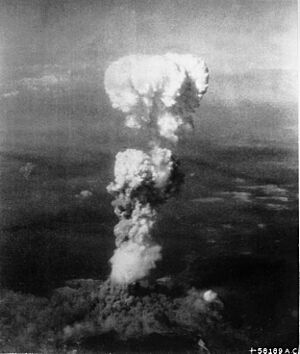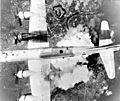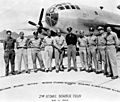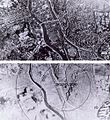Atomic bombings of Hiroshima and Nagasaki facts for kids

The atomic bombings of Hiroshima and Nagasaki were major nuclear attacks during World War II (WWII). The United States and its friends, called the Allies, were fighting against Japan. They were slowly winning the war. Two very powerful nuclear weapons were dropped on Japan. One bomb hit the city of Hiroshima and the other hit Nagasaki.
U.S. President Harry S. Truman ordered these attacks. The first bomb was dropped on August 6, 1945. The second was on August 9, 1945. This happened near the end of WWII. These atomic bombs were created through a secret project called the Manhattan Project. Nuclear bombs are much stronger than other types of bombs.
At least 66,000 people died in Hiroshima. About 39,000 people died in Nagasaki. This means over 105,000 people were killed in total. Six days after the Nagasaki bombing, Japan gave up. They surrendered to the Allied Powers on August 15. Japan officially signed the surrender paper on September 2. This event ended the Pacific War and World War II.
Contents
Why These Cities Were Chosen
Hiroshima and Nagasaki were picked for a few reasons.
- First, these cities were not good targets for regular firebombing. Their rivers would stop big fires from spreading easily.
- Second, the land around them was good for seeing how much damage the nuclear bombs caused.
- Third, both cities had important military and factory sites. Hiroshima was a main army base with 40,000 Japanese soldiers. Nagasaki had two large Mitsubishi factories. These factories made important parts for Japan's war efforts.
In both cities, these military and factory targets were mixed in with homes, schools, and temples. For example, in Hiroshima, many of those who died were soldiers and workers. In Nagasaki, many were factory employees and other workers.
The Big Decision to Use the Bombs
Many people believe the atomic bombs actually saved many lives. They think it stopped a full invasion of Japan. Without the bombs, the Allies would have had to invade Japan. This invasion could have lasted for years. More people would have been killed on both sides in such a battle. Allied generals thought an invasion could kill over a million people from each side.
Some people still argue that the bombings were not needed. No nuclear weapon has been used in fighting since August 9, 1945.
The decision to use nuclear weapons was made after studies showed many people would die if Japan was invaded. This included soldiers from both sides and regular people. The nuclear bombings were shocking. But they caused less death than the "Operation Meetinghouse" firebombing of Tokyo. That attack on March 9-10, 1945, killed 100,000 people. It destroyed 16 square miles in one night.
If the nuclear weapons were not used, the U.S. might have firebombed Hiroshima and Nagasaki. This would have caused similar damage. But it would not have had the same shocking effect as nuclear weapons. Also, doing nothing or waiting for Japan to surrender was not an option. Hundreds of thousands of soldiers, civilians, and prisoners were dying each month in Japanese-controlled lands.
Japan's Non-Nuclear Principles
Partly because of the atomic bombings, Japan made a promise after the war. They adopted the Three Non-Nuclear Principles. These rules say that Japan will not make, own, or allow nuclear weapons on its land.
Related pages
Images for kids
-
Leslie Groves, Manhattan Project director, with a map of Japan
-
Aircraft of the 509th Composite Group that took part in the Hiroshima bombing. Left to right: Big Stink, The Great Artiste, Enola Gay
-
The Enola Gay dropped the "Little Boy" atomic bomb on Hiroshima. Paul Tibbets (center in photograph) can be seen with six of the aircraft's crew.
-
For decades this "Hiroshima strike" photo was misidentified as the mushroom cloud of the bomb that formed at c. 08:16. However, due to its much greater height, the scene was identified by a researcher in March 2016 as the firestorm-cloud that engulfed the city, a fire that reached its peak intensity some three hours after the bomb.
-
The Bockscar and its crew, who dropped a Fat Man atomic bomb on Nagasaki
-
A telegram sent by Fritz Bilfinger, delegate of the International Committee of the Red Cross (ICRC), on 30 August 1945 from Hiroshima
-
Torii, Nagasaki, Japan. One-legged torii in the background
-
Memorial at Andersonville NHS for the American airmen who died in the blast.
See also
 In Spanish: Bombardeos atómicos de Hiroshima y Nagasaki para niños
In Spanish: Bombardeos atómicos de Hiroshima y Nagasaki para niños
























